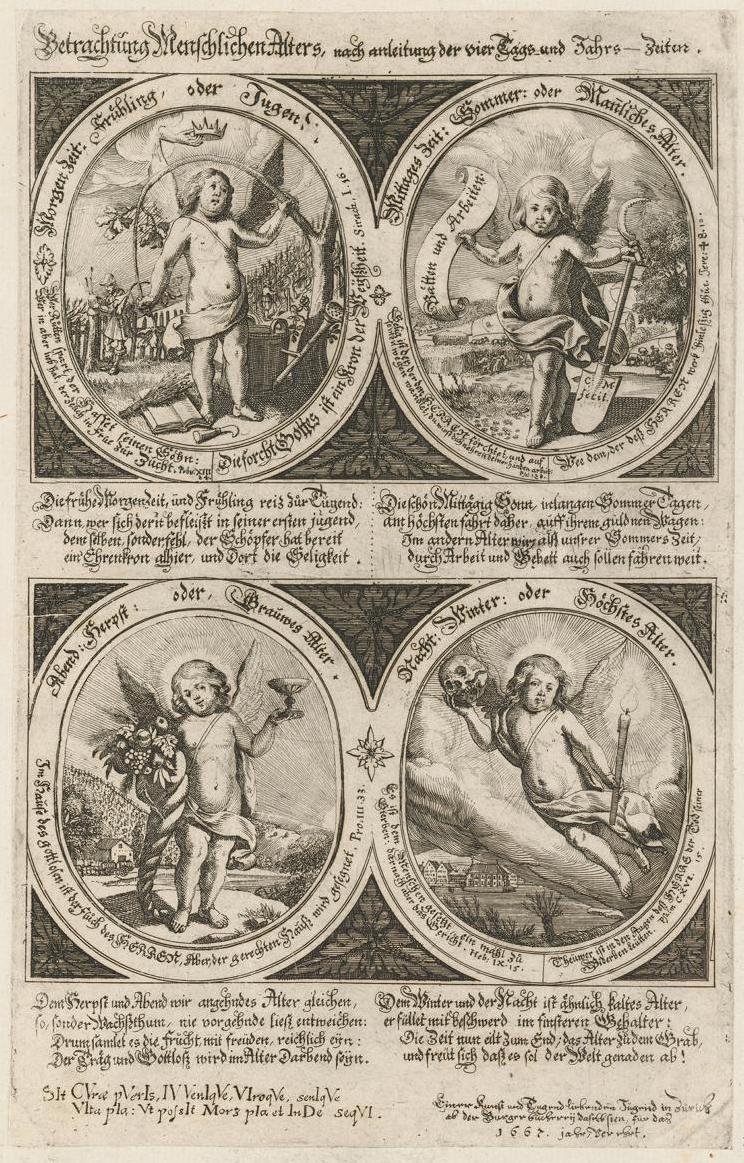New Year's leaflet 1667

Conrad Meyer
Betrachtung Menschlichen Alters, nach anleitung der vier Tags- und Jahrs-Zeiten, 1667
Radierung, 23.8 x 18 cm, Zentralbibliothek Zürich, Graphische Sammlung
At the turn of the year 1667, Conrad Meyer created a New Year's page consisting of four emblems – a popular art form in the Baroque era. The baroque emblem typically consists of a title, an image and an explanatory text. The combination of text and image conveys moral, religious or general wisdom and rules of conduct. The message remains deliberately ambiguous: viewers are invited to interpret the hidden meanings for themselves and draw personal conclusions for their own lives.
In this New Year sheet, Meyer links the four-part cycle of the seasons with that of the ages of man, a method of representation that is deeply rooted in European art history. Each season symbolizes a phase of life. Bible verses and moralizing rhymes accompany the pictures and encourage reflection on life. They warn of the consequences of a lazy lifestyle, but at the same time hold out the prospect of rewards for a godly and industrious life.
Four putti can be seen, each depicted in a seasonal landscape and holding seasonal attributes. Autumn, for example, stands for an advanced age, a time of transition and harvest. The putto is in an autumnal landscape: harvested fields, vineyards, a loaded cart and the low sun indicate the advancing year and thus the advanced age of life. In his hands, the putto holds a goblet of wine, autumn leaves, fruit and grain – symbols of the harvest and fertility.
«Abend Herpst: oder, Braunes Alter
Der Herpst und Abend wir angehndes Alter gleichen,
so, sonder Wachsthum, nie vorgehnde liess entweichen:
Drumsamlet es die frucht mit freuden, reichlich eyn:
Der Träg und Bottlotz wird im Alter Darbend seyn.»
With this verse, Meyer links the depiction of autumn with the human way of life: those who have worked hard and prayed diligently in their youth and adulthood, symbolized by spring and summer, can now hope for a rich harvest. At the same time, the depiction contains a warning: those who do not lead a life pleasing to God in their youth will come away empty-handed in old age.
Two biblical quotations frame the picture:
"In the house of the wicked is the curse of the LORD, But the house of the righteous will be blessed." Pro.III.33
"It is appointed unto man once to die, but after this the judgment." Heb: IX.15
The other emblems are designed in the same way. Together, they form a multi-layered picture, an allegory of the course of life and the cyclical nature of all existence.


